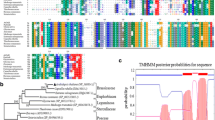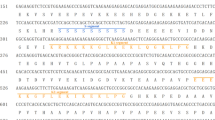Abstract
The thioredoxins (Trxs) are ubiquitous and they play a crucial role in various biological processes like growth and stress response. Although the functions of Trxs proteins are described in several previous reports, the function of the isoform Trxh2 of durum wheat (Triticum durum L.), designated as TdTrxh2, in abiotic stress response still unknown. Thus, we aimed in this study the functional characterization of TdTrxh2 through its expression in yeast cells and Arabidopsis plants. Sequence analysis revealed that TdTrxh2 protein shared the conserved redox site with the other Trxh from other plant species. Under various abiotic stresses, TdTrxh2 was up-regulated in leaves and roots of durum wheat. Interestingly, we demonstrated that TdTrxh2 exhibit protective effect on LDH activity against various treatments. Besides, the expression of TdTrxh2 in yeast cells conferred their tolerance to multiple stresses. Moreover, transgenic Arabidopsis expressing TdTrxh2 showed tolerance phenotype to several abiotic stresses. This tolerance was illustrated by high rate of proline accumulation, root proliferation, low accumulation of reactive oxygen species like H2O2 and O2·-, and high antioxidant CAT and POD enzymes activities. All these findings suggested that TdTrxh2 promotes abiotic stress tolerance through the redox homoeostasis regulation and its protective role.







Similar content being viewed by others
Data Availability
The data generated and analyzed during this study are included in this article.
References
Aebi H (1984) Catalase in vitro. Method Enzymol 105:121e126
Arsova B, Hoja U, Wimmelbacher M, Greiner E et al (2010) Plastidial thioredoxin z interacts with two fructokinase-like proteins in a thiol-dependent manner: evidence for an essential role in chloroplast development in Arabidopsis and Nicotiana benthamiana. Plant Cell 22:1498–1515
Barajas-López DDJ, Serrato AJ, Olmedilla A, Chueca A, Sahrawy M (2007) Localization in roots and flowers of pea chloroplastic thioredoxin f and thioredoxin m proteins reveals new roles in nonphotosynthetic organs. Plant Physiol 145:946–960
Beyer WF, Fridovich I (1987) Assaying for superoxide dismutase activity: some large consequences of minor changes in condition. Anal Biochem 161:559–566
Bouazzi H, Feki K, Brini F, Saibi W (2019) Is duality between proline metabolic mutation (p5cs 1–4) and durum wheat dehydrin transgenic contexts a “pacemaker” for salt tolerance process in Arabidopsis thaliana? Acta Physiol Plant 41:36
Boubakri H, Saidi MN, Barhoumi F, Kamoun H, Jebara M, Brini F (2019) Identification and characterization of thioredoxin H-type gene family in Triticum turgidum ssp. durum in response to natural and environmental factor-induced oxidative stress. Plant Mol Biol Rep 37:464–476
Boubakri H, Barhoumi F, Brahmi R, Farjallah A, Gandour M, Jebara M (2023) Genome-wide identification, characterization, and expression analysis revealed the involvement of Brachypodium H-type thioredoxin gene family in abiotic stress response. J Plant Growth Regul. https://doi.org/10.1007/s00344-022-10899-5
Bradford MM (1976) A rapid and sensitive method for the quantification ofmicrogram quantities of proteins utilizing the principle of protein-dye binding. Anal Biochem 72:248–254
Cazalis R, Pulido P, Aussena T, Perez-Ruiz JM, Cejudo FJ (2006) Cloning and characterization of three thioredoxin h isoforms from wheat showing differential expression in seeds. J Exp Bot 57:2165–2172
Chibani K, Wingsleb G, Jacquota JP, Gelhayea E, Rouhier N (2009) Comparative genomic study of the thioredoxin family in photosynthetic organisms with emphasis on Populus trichocarpa. Mol Plant 2(2):308–322
Davenport R, James RA, Zakrisson-Plogander A, Tester M, Munns R (2005) Control of sodium transport in durum wheat. Plant Physiol 137:807–818
Ding X, Li X, Xiong L (2013) Insight into differential responses of upland and paddy rice to drought stress by comparative expression profiling analysis. Int J Mol Sci 14(3):5214–5238
Drira M, Saibi W, Brini F, Gargouri A, Masmoudi K, Hanin M (2013) The K-Segments of the wheat dehydrin DHN-5 are essential for the protection of lactate dehydrogenase and β-glucosidase activities in vitro. Mol Biotechnol 54:643–650
Eswaran N, Parameswaran S, Sathram B, Anantharaman B, Kumar RKG, Tangirala SJ (2010) Yeast functional screen to identify genetic determinants capable of conferring abiotic stress tolerance in Jatropha curcas. BMC Biotechnol 10:23
Feki K, Tounsi S, Brini F (2017) Comparison of an antioxidant system in tolerant and susceptible wheat seedlings in response to salt stress. Span J Agric Res 15(4):2017
Feki K, Tounsi S, Mrabet M, Mhadhbi H, Brini F (2021) Recent advances in physiological and molecular mechanisms of heavy metal accumulation in plants. Environ Sci Pollut Res 28:64967–64986
Garrido EO, Grant CM (2002) Role of thioredoxins in the response of Saccharomyces cerevisiae to oxidative stress induced by hydroperoxides. Mol Microbiol 43(4):993–1003
Gelhaye E, Rouhier N, Jacquot JP (2004) The thioredoxin h system of higher plants. Plant Physiol Biochem 42:265–271
Gelhaye E, Rouhier N, Gérard J, Jolivet Y, Gualberto J, Navrot N, Ohlsson PI, Wingsle G, Hirasawa M, Knaff DB et al (2004) A specific form of thioredoxin h occurs in plant mitochondria and regulates the alternative oxidase. Proc Natl Acad Sci USA 101:14545–14550
Hasanuzzaman M, Bhuyan MHMB, Zulfiqar F, Raza A, Mohsin SM, Al Mahmud J, Fujita M, Fotopoulos V (2020) Reactive oxygen species and antioxidant defense in plants under abiotic stress: revisiting the crucial role of a universal defense regulator. Antioxidant 9:681
Hu B, Jin J, Guo AY, Zhang H, Luo J, Gao G (2015) Gsds 2.0: an upgraded gene feature visualization server. Bioinformatics 31:1296–1297
Ito H, Fukuda Y, Murata K, Kimura A (1983) Transformation of intact yeast cells treated with alkali cations. J Bacteriol 153:163e168
Ji MG, Park HJ, Cha JY, Kim JA, Shin GI, Jeong SY et al (2020) Expression of Arabidopsis thaliana Thioredoxin-h2 in Brassica napus enhances antioxidant defenses and improves salt tolerance. Plant Physiol Biochem 147:313–321
Kang Z, Qin T, Zhao Z (2019) Thioredoxins and thioredoxin reductase in chloroplasts: a review. Gene 706:32–42
Konez C, Schell J (1986) The promoter of TL-DNA gene 5’ controls the tissues pecific expression of chimeric genes carried by a novel type of Agrobacterium binary vector. Mol Gen Genet 204:383–396
Koubaa S, Bremer A, Hincha DK, Brini F (2019) Structural properties and enzyme stabilization function of the intrinsically disordered LEA_4 protein TdLEA3 from wheat. Sci Rep 9:3720
Lee JR, Lee SS, Jang HH, Lee YM, Park JH, Park SC, Moon JC, Park SK, Kim SY, Lee SY et al (2009) Heat-shock dependent oligomeric status alters the function of a plant-specific thioredoxin-like protein, AtTDX. Proc Natl Acad Sci USA 106:5978–5983
Lee S, Kim SM, Lee RT (2013) Thioredoxin and thioredoxin target proteins: from molecular mechanisms to functional significance. Antioxid Redox Sig 18(10):1165–1207
Liu H, Li Y, Huang X (2021) Genome-wide analysis of the thioredoxin gene family in Gossypium hirsutum L. and the role of the atypical thioredoxin gene GhTRXL3-2 in flowering. J Plant Biol 64:461–473
Livak KJ, Schmittgen TD (2001) Analysis of relative gene expression data using real-time quantitative PCR and the 2(-Delta Delta C(T)) Method. Methods 25(4):402–408
Maehly AC, Chance B (1954) The assay of catalase and peroxidase. Methods Anal Biochem 1:357e424
Mansoor S, Wani OA, Lone JK, Manhas S, Kour N, Alam P, Ahmad A, Ahmad P (2022) Reactive oxygen species in plants: from source to sink. Antioxidant 11(2):225
Marchand CH, Vanacker H, Collin V, Issakidis-Bourguet E, Le Maréchal P, Decottignies P (2010) Thioredoxin targets in Arabidopsis roots. Proteomics 10:2418–2428
Mata-Pérez C, Spoel SH (2019) Thioredoxin-mediated redox signalling in plant immunity. Plant Sci 279:27–33
Meng L, Wong JH, Feldman LJ, Lemaux PG, Buchanan BB (2010) A membrane-associated thioredoxin required for plant growth moves from cell to cell, suggestive of a role in intercellular communication. Proc Natl Acad Sci USA 107:3900–3905
Meyer Y, Siala W, Bashandy T, Riondet C, Vignols F, Reichheld JP (2008) Glutaredoxins and thioredoxins in plants. Biochim Biophys Acta 1783(4):589–600
Nikkanen L, Rintamäki E (2019) Chloroplast thioredoxin systems dynamically regulate photosynthesis in plants. Biochem J 476(7):1159–1172
Park SK, Jung YJ, Lee JR, Lee YM, Jang HH, Lee SS, Park JH, Kim SY, Moon JC, Lee SY et al (2009) Heat-shock and redox-dependent functional switching of an h-type Arabidopsis thioredoxin from a disulfide reductase to a molecular chaperone. Plant Physiol 150:552–561
Rivas S, Rougon-Cardoso A, Smoker M, Schauser L, Yoshioka H, Jones JDG (2004) CITRX thioredoxin interacts with the tomato Cf-9 resistance protein and negatively regulates defence. EMBO J 23:2156–2165
Saad BR, Romdhane BW, Bouteraa MT, Jrad O, Hsouna BA (2022) Lobularia maritima thioredoxin-h2 gene mitigates salt and osmotic stress damage in tobacco by modeling plant antioxidant system. Plant Growth Regul 97:101–115
Saad BR, Romdhane BW, Baazaoui N, Bouteraa MT, Chouaibi Y, Mnif W, Hsouna BA, Kacániová M (2023) Functional characterization of Lobularia maritima LmTrxh2 gene involved in cold tolerance in tobacco through alleviation of ROS damage to the plasma membrane. Int J Mol Sci 24(3):3030
Saad BR, Romdhane BW, Baazaoui N, Bouteraa MT, Hsouna BA, Mishra A, Zeljkovic SC (2023) Assessment of the cadmium and copper phytoremediation potential of the Lobularia maritima Thioredoxin 2 gene using genetically engineered tobacco. Agronomy 13:399
Safronov O, Kreuzwieser J, Haberer G, Alyousif MS, Schulze W, Al-Harbi N (2017) Detecting early signs of heat and drought stress in Phoenix dactylifera (date palm). PLoS ONE 12(6):e0177883
Saibi W, Feki K, Yacoubi I, Brini F (2015) Bridging between proline structure, functions, metabolism, and involvement in organism physiology. Appl Biochem Biotechnol 176:2107–2119
Serrato AJ, Crespo JL, Florencio FJ, Cejudo FJ (2001) Characterization of two thioredoxins h with predominant localization in the nucleus of aleurone and scutellum cells of germinating wheat seeds. Plant Mol Biol 46:361–371
Singh A, Kumar A, Yadav S, Singh IK (2019) Reactive oxygen species-mediated signaling during abiotic stress. Plant Gene 18:100173
Tamura K, Stecher G, Kumar S (2021) MEGA11: Molecular evolutionary genetics analysis version 11. Mol Biol Evol 38(7):3022–3027
Tounsi S, Kamoun Y, Feki K, Jemli S, Saidi MN, Ziadi H, Alcon C, Brini F (2019) Localization and expression analysis of a novel catalase from Triticum monococcum TmCAT1 involved in response to different environmental stresses. Plant Physiol Biochem 139:366–378
Tounsi S, Feki K, Kamoun Y, Saidi MN, Jemli S, Ghorbel M, Alcon C, Brini F (2019) Highlight on the expression and the function of a novel MnSOD from diploid wheat (T. monococcum) in response to abiotic stress and heavy metal toxicity. Plant Physiol Biochem 142:384–394
Tounsi S, Jemli S, Feki K, Brini F, Saidi MN (2023) Superoxide dismutase (SOD) family in durum wheat: promising candidates for improving crop resilience. Protoplasma 260:145–158
Xiao F, Zhou H (2023) Plant salt response: perception, signaling, and tolerance. Front Plant Sci 13:1053699
Zhang CJ, Zhao BC, Ge WN, Zhang YF, Song Y, Sun DY, Guo Y (2011) An apoplastic H-type thioredoxin is involved in the stress response through regulation of the apoplastic reactive oxygen species in rice. Plant Physiol 157(4):1884–99
Funding
This research has been founded by the Ministry of Higher Education and Scientific Research-Tunisia (CP- 2019-2022).
Author information
Authors and Affiliations
Contributions
HK, KF, and FB conceived and designed the work. HK, ST, and OJ carried the experiments. HK and KF analyzed the data, and KF wrote the original draft. All authors read and approved the manuscript.
Corresponding author
Ethics declarations
Competing interests
The authors declare no competing interests.
Additional information
Handling Editor: Bhumi Nath Tripathi
Publisher's note
Springer Nature remains neutral with regard to jurisdictional claims in published maps and institutional affiliations.
Supplementary Information
Below is the link to the electronic supplementary material.
Rights and permissions
Springer Nature or its licensor (e.g. a society or other partner) holds exclusive rights to this article under a publishing agreement with the author(s) or other rightsholder(s); author self-archiving of the accepted manuscript version of this article is solely governed by the terms of such publishing agreement and applicable law.
About this article
Cite this article
Kamoun, H., Feki, K., Tounsi, S. et al. The thioredoxin h-type TdTrxh2 protein of durum wheat confers abiotic stress tolerance of the transformant Arabidopsis plants through its protective role and the regulation of redox homoeostasis. Protoplasma 261, 317–331 (2024). https://doi.org/10.1007/s00709-023-01899-7
Received:
Accepted:
Published:
Issue Date:
DOI: https://doi.org/10.1007/s00709-023-01899-7




